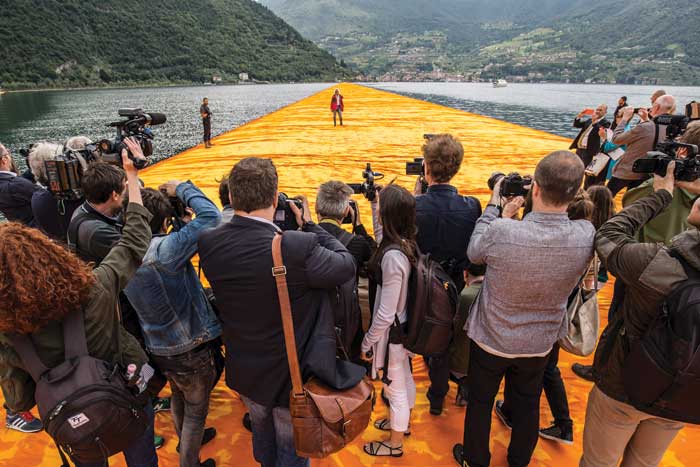Walking on Water
The opening shot of Walking on Water begins in darkness. From that gloom emerges the silhouette of an old man rooting around in his dim studio. The figure is Bulgarian-American environmental artist Christo, co-creator of massive environmental artworks involving swaths of billowing cloth and acres of landscape, sometimes swaddling architectural landmarks such as Berlin’s Reichstag and Paris’s Pont Neuf in fabric, and often decades in the making.

Christo in a scene from Walking on Water. Courtesy of Kino Lorber.
But as chronicled by director Andrey Paounov’s documentary, the stakes are especially high for The Floating Piers, an envisioned 1.9-mile-long walkway across the water. This will be Christo’s comeback piece: the first largescale project since 2005’s The Gates in Central Park and the passing of his wife and artistic collaborator, Jeanne-Claude, who died in 2009. Does the artist have one more game in him?
Walking on Water portrays Christo’s emergence from that metaphorical shadow.
In 2016, the then-80-year-old dusts off an unrealized project from 1970, The Floating Piers. Over their career, he and Jeanne-Claude only realized 23 projects; 47 failed to get permission from landowners and various agencies. Christo persuades a small community on remote Lake Iseo in northern Italy to let him join the mainland to two islands with a floating pier made of 226,000 polyethylene cubes snapped together much like Lego blocks. Covered with some 750,000-thousand square feet of dahlia yellow nylon fabric, the pier system allows visitors to “walk on the water”for the duration of the installation, June 18 to July 3, 2016. Like all of his “totally useless”art (Christo’s words), The Floating Piers will be dismantled after 16 days.
Many films have documented the art duo’s artmaking process, including several by the famed documentarians Albert and David Maysles. (Their 1974 short, Christo’s Valley Curtain, was nominated for an Academy Award.) With Walking on Water, director Paounov (The Boy Who Was a King) takes a cinema verité approach: no talking heads, no narration. As the project unfolds organically, so does the story.
With his camera operators following close to Christo, Paounov lets us glimpse into intimate and unflattering moments of a man who seems less artist than project manager. The installation involves helicopters, boats and divers. Dozens of workers, tailors and security personnel must be coordinated. Wearing his trademark beige Barbour jacket, his white curly hair ringed around his head like a halo, Christo charms attendees at innumerable community meetings and hobnobs with local dignitaries. In one telling scene, he visits a New York City elementary school. “I love real things,”he deadpans in his heavily accented English to the befuddled children. “Real things. Not virtual reality. I do not know how to drive. I do not like to talk on the telephone. I [don’t] have [the] slightest idea how to open the computer. I like to have a real one mile, two miles. Real wind. Real dry, real wet. Real fear, real joy.”
The real Christo is also cantankerous. As the timeline of Walking on Water draws closer to opening day, issues ranging from thunderstorms to disagreements about how to secure the fabric to the decking cause tempers to flare. “We do it my way!”Christo rails at one point. When finally open, The Floating Piers becomes a victim of its own success and is flooded with thousands more visitors per day than the installation can safely handle. “This is madness!”Christo unloads on the local municipal authorities. “Total madness.”
Bearing most of his wrath is his nephew Vladimir Yavachev, his right-hand-man and personal assistant of sorts. Yavachev applies Band-Aids to Christo’s face; he trims his eyelashes with a pair of scissors. Christo asks him for fashion advice: “Do you think it’s too dressy?”What emerges is not only a portrait of a driven, exacting genius at the twilight of his career, but a tender study of his and Yavachev’s relationship.
What Walking on Water doesn’t show is Christo reflecting on his career or the loss of his beloved Jeanne-Claude. Only rarely do we see him revel in what he has created. In one sequence, as the pier sections come into place, he declares: “It’s f___ing awesome. Look at that.”A later shot shows him in a helicopter on the installation’s final day, hovering godlike over his creation. For once, the man seems satisfied.

Cover art for Walking on Water: An Intimate Portrait of Christo and the High Stakes of Large-Scale Art. Directed by Andrey Paounov. Courtesy of Kino Lorber.
Ethan Gilsdorf is a frequent contributor to Art New England.
Walking on Water
Director: Andrey Paounov
kinolorber.com/film/view/id/3356
